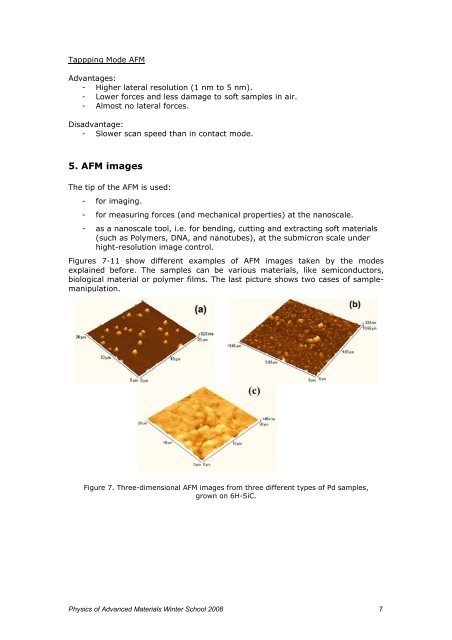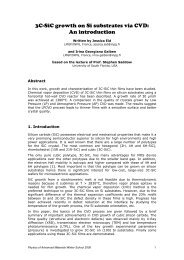Principles of Atomic rinciples Force Microscopy (AFM) - Mansic
Principles of Atomic rinciples Force Microscopy (AFM) - Mansic
Principles of Atomic rinciples Force Microscopy (AFM) - Mansic
You also want an ePaper? Increase the reach of your titles
YUMPU automatically turns print PDFs into web optimized ePapers that Google loves.
Tappping Mode <strong>AFM</strong><br />
Advantages:<br />
- Higher lateral resolution (1 nm to 5 nm).<br />
- Lower forces and less damage to s<strong>of</strong>t samples in air.<br />
- Almost no lateral forces.<br />
Disadvantage:<br />
- Slower scan speed than in contact mode.<br />
5. <strong>AFM</strong> images<br />
The tip <strong>of</strong> the <strong>AFM</strong> is used:<br />
- for imaging.<br />
- for measuring forces (and mechanical properties) at the nanoscale.<br />
- as a nanoscale tool, i.e. for bending, cutting and extracting s<strong>of</strong>t materials<br />
(such as Polymers, DNA, and nanotubes), at the submicron scale under<br />
hight-resolution image control.<br />
Figures 7-11 show different examples <strong>of</strong> <strong>AFM</strong> images taken by the modes<br />
explained before. The samples can be various materials, like semiconductors,<br />
biological material or polymer films. The last picture shows two cases <strong>of</strong> samplemanipulation.<br />
Figure 7. Three-dimensional <strong>AFM</strong> images from three different types <strong>of</strong> Pd samples,<br />
grown on 6H-SiC.<br />
Physics <strong>of</strong> Advanced Materials Winter School 2008 7




